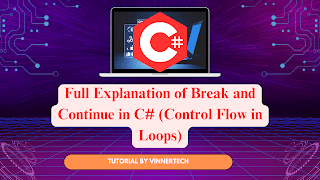Full Explanation of Break and Continue in C# (Control Flow in Loops)
Introduction: Understanding Break and Continue in C#
In C#, the break and continue statements are powerful control flow statements used within loops (such as for, while, and do-while). They allow you to alter the normal execution of a loop based on specific conditions. Understanding when and how to use these statements will enhance your ability to control your program’s flow and optimize your code.
In this blog, we’ll explore the break and continue statements in detail, with examples to help you understand how to use them effectively in your C# applications.
1. Break Statement in C#
The break statement is used to exit a loop prematurely, stopping the loop’s execution and moving on to the next statement after the loop.
When to Use the break Statement:
- To exit the loop immediately when a specific condition is met.
- To avoid unnecessary iterations once the goal is achieved.
Syntax:
break;
Example:
for (int i = 0; i < 10; i++)
{
if (i == 5)
{
break; // Exit the loop when i equals 5
}
Console.WriteLine(i);
}
Output:
0
1
2
3
4
Explanation:
In this example, the for loop starts with i = 0 and runs until i < 10. However, when i equals 5, the break statement is encountered, which immediately terminates the loop. As a result, the loop prints the numbers 0 to 4 and stops before printing 5.
2. Continue Statement in C#
The continue statement is used to skip the remaining code inside the loop for the current iteration and move to the next iteration of the loop.
When to Use the continue Statement:
- To skip certain iterations of the loop based on specific conditions.
- To avoid executing certain parts of the loop when conditions are not met.
Syntax:
continue;
Example:
for (int i = 0; i < 10; i++)
{
if (i % 2 == 0)
{
continue; // Skip even numbers
}
Console.WriteLine(i);
}
Output:
1
3
5
7
9
Explanation:
In this example, the for loop iterates from 0 to 9. However, when i is an even number (i.e., when i % 2 == 0), the continue statement is encountered. This causes the loop to skip the current iteration and move to the next one. As a result, only odd numbers (1, 3, 5, 7, 9) are printed.
Key Differences Between Break and Continue
Best Practices for Using Break and Continue in C#
- Use the
breakstatement judiciously to avoid infinite loops and unexpected termination of the loop. It’s best used when you have a clear reason to stop the loop (such as finding a match or completing a task). - Use the
continuestatement when you need to skip certain iterations based on conditions. This helps avoid unnecessary operations within the loop and improves code readability. - Be mindful of excessive use of
breakandcontinueas they can make your code harder to understand and maintain, especially in complex loops.
Conclusion: Mastering Loop Control in C#
The break and continue statements in C# provide flexibility and control over the flow of loops. By using these statements effectively, you can improve the readability and efficiency of your code. Whether you're stopping a loop early with break or skipping certain iterations with continue, understanding how to use these control flow statements is essential for building robust C# programs.





0 Comments